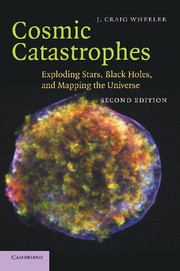Book contents
- Frontmatter
- Contents
- Preface
- 1 Setting the stage: star formation and hydrogen burning in single stars
- 2 Stellar death: the inexorable grip of gravity
- 3 Dancing with stars: binary stellar evolution
- 4 Accretion disks: flat stars
- 5 White dwarfs: quantum dots
- 6 Supernovae: stellar catastrophes
- 7 Supernova 1987A: lessons and enigmas
- 8 Neutron stars: atoms with attitude
- 9 Black holes in theory: into the abyss
- 10 Black holes in fact: exploring the reality
- 11 Gamma-ray bursts, black holes and the Universe: long, long ago and far, far away
- 12 Supernovae and the Universe
- 13 Wormholes and time machines: tunnels in space and time
- 14 Beyond: the frontiers
- Index
7 - Supernova 1987A: lessons and enigmas
Published online by Cambridge University Press: 14 September 2009
- Frontmatter
- Contents
- Preface
- 1 Setting the stage: star formation and hydrogen burning in single stars
- 2 Stellar death: the inexorable grip of gravity
- 3 Dancing with stars: binary stellar evolution
- 4 Accretion disks: flat stars
- 5 White dwarfs: quantum dots
- 6 Supernovae: stellar catastrophes
- 7 Supernova 1987A: lessons and enigmas
- 8 Neutron stars: atoms with attitude
- 9 Black holes in theory: into the abyss
- 10 Black holes in fact: exploring the reality
- 11 Gamma-ray bursts, black holes and the Universe: long, long ago and far, far away
- 12 Supernovae and the Universe
- 13 Wormholes and time machines: tunnels in space and time
- 14 Beyond: the frontiers
- Index
Summary
THE LARGE MAGELLANIC CLOUD AWAKES
The first supernova discovered in 1987 turned out to be the most spectacular supernova since the invention of the telescope. SN 1987A was the first supernova easily observable with the naked eye since the one recorded by Kepler in 1604. This event also brought the first direct confirmation that our basic picture of the exotic processes that mark the death of a massive star is correct. SN 1987A is the best-studied supernova ever, but the story is still unfolding, and there is much to learn.
SN 1987A did not explode in our Galaxy, but in a nearby satellite galaxy to our own Milky Way galaxy. This satellite galaxy cannot be seen from the northern hemisphere. The first European to record it was Magellan during his epic attempt to sail around the world. In English, it carries the name of the Large Magellanic Cloud for this reason. People native to the southern hemisphere were undoubtedly familiar with it before that. The Aborigines living around Sydney had long had another name for it: Calgalleon, which had to do with a woolly sheep. The Large Magellanic Cloud has a somewhat smaller companion that has picked up the unimaginative name, Small Magellanic Cloud. In the same Aboriginal dialect, it was rendered Gnarrangalleon. There is poetry!
The Large Magellanic Cloud is only 150 000 light years away, as shown in Figure 7.1. This is not much farther than the span across the Milky Way itself, about 50 000 light years.
- Type
- Chapter
- Information
- Cosmic CatastrophesExploding Stars, Black Holes, and Mapping the Universe, pp. 118 - 140Publisher: Cambridge University PressPrint publication year: 2007



